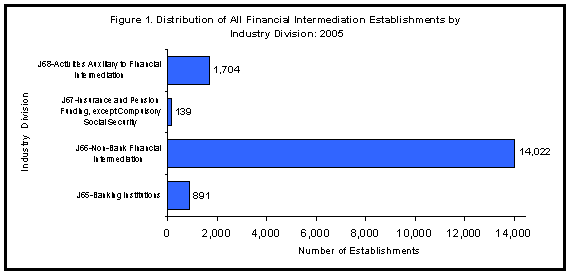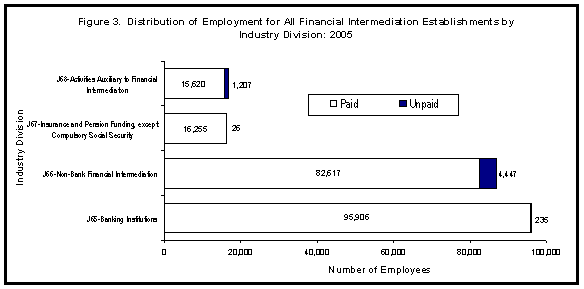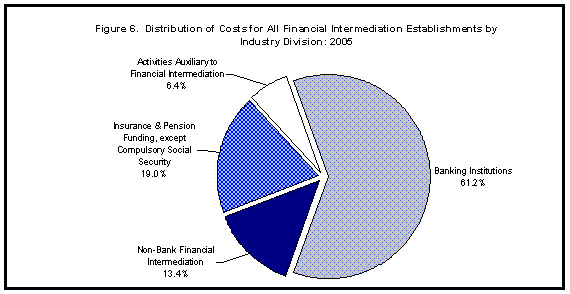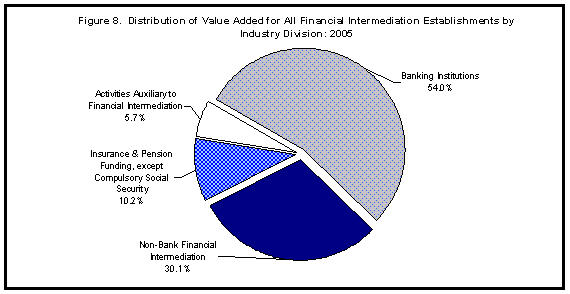2005 ANNUAL SURVEY of PHILIPPINE BUSINESS
and INDUSTRY (ASPBI)
FINANCIAL INTERMEDIATION SECTOR
PRELIMINARY RESULTS
Non-Bank Financial Intermediation establishments dominate Financial Intermediation Sector
· The 2005 Annual Survey of Philippine Business and Industry covered a total of 16,756 Financial Intermediation establishments. Of the total figure, 15,980 establishments or 95.4 percent had an average total employment (ATE) of less than 20. The remaining 776 establishments or 4.6 percent had an average total employment of 20 or more.
· Non-Bank Financial Intermediation (PSIC J66) dominated the sector with 14,022 establishments. This represented 83.7 percent of the total financial intermediation establishments. Activities Auxiliary to Financial Intermediation (PSIC J68) followed next with 1,704 establishments (10.2%) while Banking Institutions (PSIC J65) ranked third with 891 establishments (5.3%). On the other hand, establishments engaged in Insurance and Pension Funding except Compulsory Social Security (PSIC J67) recorded the least number of establishments with 139 or 0.8 percent of the total. Figure 1 shows the distribution of establishments by industry division.

· Regionwise, more than half (58.2%) or 452 establishments of the total Financial Intermediation establishments with average total employment of 20 or more in the country were concentrated in National Capital Region (NCR). Neighboring regions of CALABARZON, and Central Luzon had 58 establishments (7.5%) and 54 establishments (7.0%), respectively. Figure 2 shows the distribution of establishments by region.

Banking Institutions are the top employers in the sector
· Financial Intermediation establishments generated jobs for an estimated 216,312 workers. Of the total work force, 210,398 (97.3%) were paid employees and 5,914 (2.7%) were working owners or unpaid workers.
· More than half (60.5%) of Financial Intermediation workers (130,963) were employed in large establishments with an average total employment (ATE) of 20 or more. The remaining 85,349 employees (39.5%) were employed in small establishments with average total employment (ATE) of less than 20. (See Tables B & C for summary statistics for large and small establishments).
· Banking Institutions (PSIC J65) and Non-Bank Financial Intermediation (PSIC J66) establishments were the top employers in the sector which employed 96,141 workers (44.4%) and 87,063 workers (40.2%), respectively. Insurance and Pension Funding except Compulsory Social Security (PSIC J67) employed the least number of workers with 16,281 persons (7.5%). Figure 3 shows the distribution of employment by industry division.

Employees in the Banking sector receive the highest pay
· Total remuneration paid to employees by financial intermediation establishments amounted to PhP71.51 billion in 2005 or equivalent to an average annual remuneration of PhP339,884 per worker.
· Banking Institutions (PSIC J65) reported the biggest chunk (64.9%) in compensation with an estimated amount of PhP46.45 billion. This was followed by Non-Bank Financial Intermediation (PSIC J66) with PhP15.25 billion (21.3%). On the other hand, Activities Auxiliary to Financial Intermediation (PSIC J68) posted the least share in compensation with PhP3.96 billion (5.5%).
· Highest earners were employees in Banking Institutions (PSIC J65) with an average monthly pay of PhP40,357. Far second were workers in Insurance and Pension Funding, except Compulsory Social Security (PSIC J67) with PhP30,013 monthly pay. Meanwhile, workers in Non-Bank Financial Intermediation (PSIC J66) establishments received the lowest average monthly pay of PhP15,386. Figure 4 shows the distribution of average monthly compensation by industry division.

More than half of the sector�s total revenue is contributed by Banking Institutions
· In 2005, the total revenue generated by the sector reached PhP621.06 billion.
· Banking Institutions (PSIC J65) earned the highest revenue of PhP354.75 billion, accounting for more than half (57.1%) of the sectors total revenue. Non-Bank Financial Intermediation (PSIC J66) placed second which generated PhP132.28 billion (21.3%) while Insurance and Pension Funding, except Compulsory Social Security (PSIC J67) ranked third with PhP98.32 billion (15.8%). Activities Auxiliary to Financial Intermediation (PSIC J68) generated the least income amounting to PhP35.71 billion (5.8%). Figure 5 shows the distribution of revenue by industry division.

· The biggest contributor to the revenue of Activities Auxiliary to Financial Intermediation (PSIC J68) were pre-need plan companies (PSIC J6814) with a total revenue of PhP23.52 billion or 65.9 percent of the total of the industry division.
Operational cost in Financial Intermediation sector totals to PhP376.65 billion
· Cost for operating Financial Intermediation establishments in 2005 was estimated at PhP376.65 billion.
· Banking Institutions (PSIC J65) being the biggest earner was also the biggest spender which incurred PhP230.52 billion or more than half (61.2%) of the sectors total costs. Trailing behind was Insurance and Pension Funding, except Compulsory Social Security (PSIC J67) and Non-Bank Financial Intermediation (PSIC J66) with PhP71.44 billion (19.0%) and PhP50.63 billion (13.4%), respectively. Activities Auxiliary to Financial Intermediation (PSIC J68), spent the least amount of PhP24.06 billion (6.4%). Figure 6 shows the distribution of costs by industry division.

Revenue per peso cost is PhP1.65
· The ratio of revenue per peso cost by Financial Intermediation establishments was estimated at 1.65. This means that for every peso spent by the industry, a corresponding revenue of PhP1.65 was generated.
· Non-Bank Financial Intermediation (PSIC J66) is the only industry in the sector that surpassed the national average revenue per peso cost, at PhP2.61. This was followed by Banking Institutions (PSIC J65) and Activities Auxiliary to Financial Intermediation (PSIC J68) with a ratio of PhP1.54 and PhP1.48, respectively. Figure 7 shows the revenue per peso cost by industry division.

Total gross additions to fixed assets amounts to PhP11.82 billion
· Total gross additions to fixed assets acquired by financial intermediation establishments were assessed at PhP11.82 billion in 2005.
· Banking Institutions (PSIC J65) added the largest acquisition to fixed assets amounting to PhP5.76 billion or 48.7 percent of the total. This was followed by Non-Bank Financial Intermediation (PSIC J66) with an addition to fixed assets worth PhP2.94 billion (24.9%). On the other hand, Activities Auxiliary to Financial Intermediation (J68) had the least additions to fixed assets amounting to PhP384.44 million (3.3%).
Value Added generated by the sector reaches PhP311.50 billion
· The total value added generated by the Financial Intermediation establishments was estimated at PhP311.50 billion.
· Banking Institutions (PSIC J65) registered the highest value added with PhP168.21 billion or a little more than half (54.0%) of the total. Non-Bank Financial Intermediation (PSIC J66) followed next with PhP93.81 billion (30.1%) while establishments engaged in Insurance and Pension Funding, except Compulsory Social Security (PSIC J67) contributed PhP31.82 billion (10.2%). Activities Auxiliary to Financial Intermediation (PSIC J68) had the least share to total value added worth PhP17.66 billion (5.7%). Figure 8 shows the distribution of value added by industry division.

Subsidies provided by government stand at PhP426.69 million
· The total subsidies granted by government to support the operation of financial intermediation establishments reached PhP426.69 million in 2005.
· Banking Institutions (PSIC J65) received the highest financial aid from the government amounting to PhP319.39 million or 74.9 percent of the total subsidies. Non-Bank Financial Intermediation (PSIC J66) followed with PhP107.31 million (25.1%) in government subsidy. The other industries did not receive any subsidy from the government in 2005.
Technical Notes
Scope and Coverage
The 2005 Annual Survey of Philippine Business and Industry (ASPBI) formerly known as Annual Survey of Establishments (ASE) was conducted to collect information on the structure and trends of economic activities in the entire country for the year 2005. Covered were establishments engaged in economic activities as defined under the amended 1994 Philippine Standard Industrial Classification (PSIC).
These establishments were classified into 14 sectors, one of which was on Financial Intermediation (Sector J). The sector is composed of establishments engaged in four industry divisions, namely: banking institution (J65); non-bank financial intermediation (J66); insurance and pension funding, except compulsory social security (J67) and activities auxiliary to financial intermediation (J68).
All financial intermediation establishments nationwide with average total employment (ATE) of less than 20 and 20 to 99 were selected using simple random sampling and establishments with average total employment (ATE) of 100 or more were covered on a 100 percent basis. For this survey year, the branches of Banking Institutions (PSIC J65) were excluded as samples instead they were included in the report of their main offices.
Response
A total of 978 or 97.90 percent responded out of the 999 samples drawn for the sector but the effective response rate is 70.20 percent only. Adjustments for non-response were made through imputations.
Concepts and Definition of terms
Establishment is an economic unit, which engages under a single ownership or control, i.e. under a single legal entity, in one, or predominantly one kind of economic activity at a single fixed location.
Economic activity or business is the activity of the establishment as classified under the amended 1994 Philippine Standard Industrial Classification (PSIC). The main activity refers to the activity that contributes the biggest or major portion of the gross income or revenue of the establishment.
Financial intermediation is a productive activity in which an institutional unit incurs liabilities on its own account for the purpose of acquiring financial assets by engaging in financial transactions on the market; the role of financial intermediaries is to channel funds from lenders to borrowers by intermediating between them.
Financial Intermediaries are units which incur liabilities on their own account on financial markets by borrowing funds which they lend on different terms and conditions to other institutional units.
Financial Establishment - Bank, savings and loan association, credit institution, pawnshop, financial institution, trust company, investment company, pawn broker, or institution engaged in accepting of deposits, granting loans and the investment of money; dealer, broker or office engaged in investment research and counseling, check cashing, stock quotation, foreign exchange dealing and other financial services.
Insurance, Pre-Need Plan Companies and Pension Funding Establishments - Life insurance companies; non-life insurance for fire, marine, accident, health, title, financial obligation, casualty, fidelity and surety; agents and brokers servicing insurance carriers, consultant for policyholders; fund managers.
Insurance - the activity of insurance is intended to provide individual institutional units exposed to certain risks with financial protection against the consequences of the occurrence of specified events; it is also a form of financial intermediation in which funds are collected from policyholders and invested in financial or other assets which are held as technical reserves to meet future claims arising from the occurrence of the events specified in the insurance policies.
Life Insurance is a type of insurance that pays a benefit if the person who is insured by the contract dies while the insurance is in force. It provides a monetary benefit to a decedent's family or other designated beneficiary, and may specifically provide for burial, funeral and other final expenses. Life insurance policies often allow the option of having the proceeds paid to the beneficiary either in a lump sum cash payment or an annuity.
Non-life Insurance means insurance other than life insurance such as fire, marine, accident, medical, motor vehicle and household insurance.
Pre-Need Plans are contracts which provide for the performance of future service/s or payment of future monetary consideration at the time of actual need, payable either in cash or installment by Planholders at prices stated in the Contract with or without interest or insurance coverage and includes life, pension, education, interment, and other plans which the Commission may from time to time approve.
Pre-Need Company or Issuer means any corporation registered with the Commission and authorized/licensed to sell or offer for sale Pre-Need Plans. A Pre-Need Company may be a single plan (selling one type of Pre-Need Plan) or multi-plan (selling more than one (1) type of Pre-Need Plan).
Employee is a person who enters an agreement, which may be formal or informal, with an enterprise to work for the enterprise in return for remuneration in cash or in kind.
Total Employment is the number of persons who worked in or for the establishment as of November 15, 2005.
Paid employees are all persons working in the establishment receiving pay as well as those working away from the establishment when paid by and under the control of the establishment. Included are persons working as full-time or part-time and those employees on sick leave or maternity leave, paid vacation or holiday. Excluded are consultants, home workers and workers receiving commission only.
Unpaid workers include working owners who do not receive regular pay, apprentices and learners without regular pay, and persons working without regular pay for at least one third of the working time normal to the establishment.
Gross Salaries and wages refer to payments in cash or in kind prior to any deductions for employees contribution to SSS/GSIS, withholding tax, etc. It Includes total basic pay, vacation/sick/maternity leave pay, overtime pay, bonuses, food/housing/cost of living allowances, commissions paid to salaried employees, commutable transportable and representation allowances, separation/retirement/terminal pay, gratuities and share of harvest given to employees as salaries and wages valued at net cost. Excluded are cost of uniform/working clothes, and reimbursable transportable and representation allowances.
Employers contributions to SSS/GSIS, etc. include contributions to Employees Compensation Commission (ECC), PhilHealth and Pag-ibig, SSS/GSIS, and other social security schemes.
Compensation is the sum of gross salaries and wages and employers contributions to SSS/GSIS, etc.
Revenue refers to cash received and receivables for goods sold and services rendered.
Cost refers to all expenses excluding compensation incurred during the year whether paid or payable. Valuation should be at market price including taxes and other charges, net of discounts, rebates, returns and allowances. Goods received from and services rendered by other establishment of the same enterprise are valued as though purchased
Gross additions to fixed assets refer to the cost of acquisition of fixed assets acquired in 2005 less the value of sales of fixed assets during the year.
Sale of fixed assets refers to the actual amount received/realized for the sale of fixed assets during the year, including the value of fixed assets transferred to other establishments of the same enterprise.
Fixed assets are physical assets expected to have productive life of more than one year and intended for use and/or being used by the establishment. Included are land, buildings, fixtures, machinery, tool, furniture, office equipment, vehicles, and the like.
Capital expenditures refer to the cost of acquisition of fixed assets acquired in 2005 whether or not full payments have been made.
Book Value of fixed assets refers to the initial of acquisition cost of fixed assets less accumulated depreciation charges. Included also is the capital expenditures during the year.
Subsidies are special grants in the form of financial assistance or tax exemption or tax privilege given by the government to develop an industry or production and to protect it against competition.
Inventories refer to stocks of goods owned by or under the control of the establishment as of a fixed date, regardless of where the stocks are located. Valuation should be at current replacement cost in purchasers price at the indicated dates. Replacement cost is the cost of an item in terms of its present price rather than its original price.
Change in Inventories as a derived indicator is computed as the value of ending inventory less the value of beginning inventory.
Value added is equal to the sum of total revenue and cost of fixed assets produced on own account less the following items - cost of materials and supplies purchased; cost of goods purchased for resale; cost of real estate purchased for sale; cost of fuels purchased to run vehicles, machinery and other equipment; cost of electricity purchased; cost of industrial services done by others; cost of non-industrial services done by others; cost of computer software expenses; cost of research and experimental development; and other costs (except indirect taxes for banking institutions and financial intermediaries; and indirect taxes and interest expense for insurance); this result being corrected for change in inventories.
Source: National Statistics Office
Manila, Philippines
